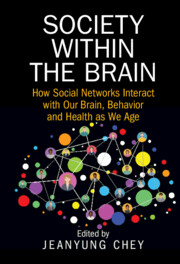Book contents
- Society within the Brain
- Society within the Brain
- Copyright page
- Dedication
- Contents
- Figures
- Tables
- Contributors
- Preface
- Introduction
- Part I Approaches to Society within the Brain
- Chapter 1 A Case of a Rapidly Aging Society and Its Dementia Population
- Chapter 2 Social Network Positions and Health Status in Older Adults
- Chapter 3 The Social Brain and How It Links Social Intelligence and Well-Being
- Chapter 4 The Genomics of Cognitive Aging in Social Isolation
- Part II Society Interacting with Brain, Cognition, and Health in Late Life
- Part III An Individual’s Cognitive Aging with Others: Key Findings, Issues, and Implications
- Index
- References
Chapter 4 - The Genomics of Cognitive Aging in Social Isolation
from Part I - Approaches to Society within the Brain
Published online by Cambridge University Press: 28 September 2023
- Society within the Brain
- Society within the Brain
- Copyright page
- Dedication
- Contents
- Figures
- Tables
- Contributors
- Preface
- Introduction
- Part I Approaches to Society within the Brain
- Chapter 1 A Case of a Rapidly Aging Society and Its Dementia Population
- Chapter 2 Social Network Positions and Health Status in Older Adults
- Chapter 3 The Social Brain and How It Links Social Intelligence and Well-Being
- Chapter 4 The Genomics of Cognitive Aging in Social Isolation
- Part II Society Interacting with Brain, Cognition, and Health in Late Life
- Part III An Individual’s Cognitive Aging with Others: Key Findings, Issues, and Implications
- Index
- References
Summary
Loneliness is a complex trait that has been linked to negative mental and physical health outcomes, including cognitive impairment. With mounting efforts to examine the underlying mechanisms of the link between loneliness and health, recent genomics studies suggest genetic predispositions associated with social isolation and cognitive functions. Ongoing genome-wide association studies (GWASs) have identified several genetic loci linked to age-related neuropathological conditions, including the apolipoprotein E (APOE e4) allele. Moreover, emerging evidence suggests genetic influences on loneliness and social integration. In addition to the genetic factors, social genomic research suggests altered gene expression patterns under social isolation or neurodegenerative diseases; for example, chronic loneliness triggers less effective immune response gene expression patterns (conserved transcriptional response to adversity [CTRA]) in white blood cells. Moreover, a recent transcriptional analysis reported altered gene expression patterns associated with myelination in the prefrontal cortex of patients with Alzheimer’s disease. These genomics studies not only suggest that loneliness and neuropathological processes are polymorphic heritable traits but also that genetic variants interact with environmental factors regulating gene expressions on the transcriptional level. This chapter focuses on social genomics research that investigates the favorable social conditions (e.g., social integration) linked to altering gene expression profiles.
Keywords
- Type
- Chapter
- Information
- Society within the BrainHow Social Networks Interact with Our Brain, Behavior and Health as We Age, pp. 105 - 116Publisher: Cambridge University PressPrint publication year: 2023

